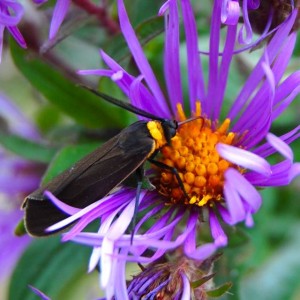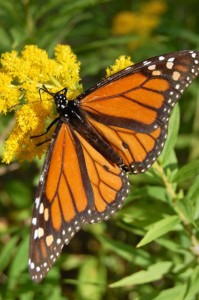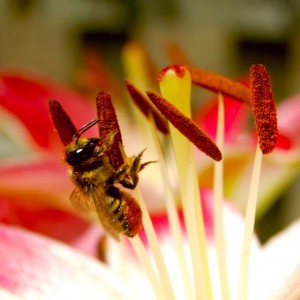Most of the earth’s ecosystems, including much of our food supply, are dependent on pollinators.
Embedded in the ground as they are, most flowering plants need help to reproduce. Over 80 percent of flowering plants need pollinators such as birds, bees, butterflies, and other animals to facilitate pollination so they can develop seed or fruit. Having pollinators available is as essential to most flowering plants as light, water, and good soil.
Any flower or edible garden with flowering plants supports pollinators to some extent. Yet the vast decline of pollinators worldwide, with hundreds of pollinator species on the verge of extinction, makes it imperative to provide extra support to ensure that pollinators have access to the habitat that they need.
That’s where a pollinator garden comes in.
A pollinator garden is any garden where the design and plant choices are focused on attracting pollinators – lots of pollinators. It’s a garden where the gardener considers the pollinator potential of a plant before placing it in the garden and tries to maximize the opportunities for different types of pollinators to visit. It’s a garden that has a diversity of flowering plants – with an emphasis on native plants – and that is environmentally friendly as well as beautiful.
Pollination Basics
Pollination is central to the reproduction of most flowering plants. It is the process of moving pollen from the male parts of flowers (anthers) to fertilize the female parts of flowers (stigmas). A few plants are capable of self-pollination, of moving the pollen from within a single flower or between flowers of the same plant (e.g., orchids, tomatoes, and peas). Most plants, however, rely on cross-pollination between plants of the same species.
Flowering plants have evolved any number of ways to spread their pollen, including the wind (used by corn, wheat, and rice as well as by conifers, grasses, and sneeze-inducing ragweed). A few plants use water to spread their pollen (waterweeds and pondweeds). But the majority of flowering plants depend on insects, birds, bats and other animals for pollination. Plants use visual cues such as petal colour and design, or olfactory cues (scent), or both, to attract the pollinators.
Most flowering plants count on multiple pollinators. Some depend on a few specialized pollinators and a small group of flowering plants depend on only one species. But the more visits any of these plants get from the pollinators they need, the better their chances of reproduction.

Moths are pollinators, too. Here is a yelllow-collared scape moth on a new-world aster flower (Symphyotrichum). (Photo: Helen Battersby)
Pollinators
Insects are by far the most important pollinators: bees and wasps, flies, butterflies, moths, and beetles. A few plants use hummingbirds, other birds, or small animals as pollinators (e.g., bats pollinate giant saguaro cacti and agave in the southern US).
Pollinators are after three main types of food: nectar (a source of energy), pollen (a source of protein) and a host plant to eat and lay their larvae in (the caterpillars of butterflies and moths).
Bees are the most important pollinators. Unlike other pollinators, bees deliberately collect pollen as food for their larvae. As they travel from flower to flower gathering pollen, a small amount rubs off their bodies and is deposited on the flowers they visit, resulting in cross-pollination. The fact that bees both collect and transfer pollen makes them more useful than pollinators like butterflies, flies and beetles that gather nectar and only inadvertently make contact with the pollen. Even so, their chance transmission of pollen makes them valuable pollinators.
Pollinator Decline
The numbers of pollinating insects have declined markedly over the past decade. Although systemic pesticides such as neonicotinoids have been implicated in the decline of honeybees as well as other pollinators such as the bumblebee for the past decade, recent studies and sources attribute causes to other factors as well.
Another pollinator in huge decline is the monarch butterfly, whose milkweed habitat in eastern North America has been largely depleted over the last decade. Gardeners are being encouraged to plant native milkweed species such as Asclepias syriaca (Common Milkweed), Asclepias tuberosa (Butterfly weed) and Asclepias incarnata (Swamp Milkweed).
All most pollinators need is a place full of flowers to forage in, suitable host plants where they can lay their eggs, and a pesticide-free environment. Even the smallest change we make to enhance the habitat of pollinators will be of benefit, not just to the bees and the butterflies, but to all of us, to our own habitat and our food supply.

A Monarch butterfly (male; note the two wing spots) sipping from goldenrod flowers (Photo: Helen Battersby)
Creating a Pollinator Garden
The first step in creating a pollinator garden is to assess the garden that you already have. Look at your soil, light conditions, and exposure. Depending on where you live in the Greater Toronto Area (GTA), you may have very sandy soil or heavy clay – both of which can be improved by the addition of organic matter such as compost.
Most GTA gardens have a mixture of light conditions. Most flowering plants prefer sunny locations, so the sunnier the better – but some pollinator plants will do well in shade or partial shade.
The next step is to make a list of plant choices for each of the growing seasons. What plants do you already have that are attracting pollinators? Consider plants from the references below to provide additional blooms or as host plants for pollinator food and shelter.
There are extensive lists of pollinator plants suitable for the GTA available at these websites:
Credit Valley Conservation. Native plants for pollinators. 2017 https://cvc.ca/wp-content/uploads/2017/04/17-uo-nativeplantsforpollinators-booklet-v8-web.pdfCredit Credit Valley
The Pollinator Partnership. Selecting plants for pollinators. A guide for gardeners, farmers and land managers in the Lake Erie Lowland Ecoregion. 2017 https://www.pollinator.org/pollinator.org/assets/generalFiles/LakeErieLowlands.2017.pdf
Xerxes Society. Pollinator plants: Great Lakes Region. 2017. https://xerces.org/publications/plant-lists/pollinator-plants-great-lakes-region
Key Elements of a Pollinator Garden
A pollinator garden can be big or small – planted in a large empty urban lot or in small pots and containers on a balcony. The key to attracting pollinators is imitating nature including these elements:
A diversity of plants to attract a diversity of pollinators.
Plants of different heights – trees, shrubs, vines, and plants. These can be planted to give the effect a layered canopy, even in a small container garden.
Groupings of single species of plants (use mass planting, if possible) to minimize pollinator search time and to allow them to collect pollen and/or nectar more efficiently.
A sequence of bright-coloured and fragrant blooms from spring to the end of fall.
Plant primarily native plants which link up directly to native pollinators’ needs (native plants are four times more likely to attract native bees than non-natives). This may mean reassessing some plants such as goldenrod (Solidago canadensis) that provide pollen and nectar late in the season.
When using non-native plants that attract pollinators – herbs such as parsley, basil and sage, or flowers such as alyssum, calendula, or cosmos – try to plant heirloom varieties, which have more accessible nectar and pollen than hybrids.
Do not use pesticides or any other remedies that could harm the pollinators.
Offer shelter and nesting sites to pollinators by allowing some parts of the garden to be a little “wild.”
Provide fresh water in bird baths or other containers for pollinators of all types.
Attracting Pollinators to your Balcony
The key principles of a pollinator garden apply equally to a balcony pollinator garden. In fact, it is even more important for balcony gardeners than gardeners planting at ground level to attract pollinators, because pollinators are less likely to appear many storeys up unless there is plenty of nectar and pollen on offer. Non-pollination is more common on balconies, where gardeners report such problems as having lots of squash flowers but no fruit. Rather than turning to self-pollination – by brushing the flowers daily to help the pollination process, as recommended by some gardening books – why not entice pollinators to the balcony and let them do the work.
Balcony pollinator gardens are most successful if they’re sunny and sheltered from wind. Creating a windbreak using a trellis or screen or native shrubs like juniper or viburnum will help shield plants from the wind. If the balcony is heavily shaded, choose shade-loving pollinator plants such as Hosta (Plantain lily), Aquilegia (columbine), Alchemilla mollis (lady’s mantle), and Gillenia trifoliata (Bowman’s root).
Even the smallest of balconies should aim for a diversity of plant material. Using plants of varying heights, including annuals, wildflowers, flowering vines and potted shrubs and trees is most effective. To save space, herbs such as thyme and oregano can be planted around your potted shrubs and trees to act as mulch as well as food for pollinators.
A balcony pollinator garden should also focus on native plants, which are first choice for native pollinators. In addition, native plants tend to need less water, a boon on a balcony where watering is often difficult. Silvery-leaved non-natives like rosemary, lavender and sage are also relatively drought-tolerant and valuable in attracting pollinators.
Like a pollinator garden at ground level, a balcony pollinator garden aims to ensure that every plant will attract pollinators as well as provide a decorative element or produce fruit or vegetables.
References
OMAFRA. (2021, February 12). Pollinator Health Information for Gardeners. http://www.omafra.gov.on.ca/english/pollinator/info-gardeners.htm/
The Pollinator PartnershipTM/North American Pollinator Protection Campaign. (2017) Selecting Plants for Pollinators. A Guide for Gardeners, Farmers, and Land Managers In the Lake Erie Lowland Ecoregion: The Greater Toronto Area, the Golden Horseshoe, Sarnia, London, Windsor and Niagara Region.https://www.pollinator.org/pollinator.org/assets/generalFiles/LakeErieLowlands.2017.pdf/
Xerces Society. (2017) Pollinator Plants. Great Lakes Region. https://xerces.org/publications/plant-lists/pollinator-plants-great-lakes-region/
Landscape Ontario. (2016, April 26). Tips to make your garden more pollinator friendly. https://landscapeontario.com/pollinator-friendly-garden/
David Suzuki Foundation. (2021). How to create a pollinator-friendly garden. https://davidsuzuki.org/queen-of-green/create-pollinator-friendly-garden-birds-bees-butterflies/
Credit Valley Conservation. (2017). Native Plants for Pollinators. https://cvc.ca/wp-content/uploads/2017/04/17-uo-nativeplantsforpollinators-booklet-v8-web.pdf
City of Toronto. Wild About Bees: What you can do to help native pollinators. https://www.toronto.ca/services-payments/water-environment/live-green-toronto/tips-to-create-a-pollinator-friendly-garden/
OMAFRA. (2018) Ontario Apiculture Winter Loss Survey. http://www.omafra.gov.on.ca/english/food/inspection/bees/2018winterloss.htm#intro/
Cornell university. Pollinator Network @ Cornell. (2021). Neonicotinoids. https://pollinator.cals.cornell.edu/threats-wild-and-managed-bees/pesticides/neonicotinoids/
Daynard, T. (2017, April 17) Comments on “Status and Trends of Pollinator Health in Ontario” (A review by Pindar et al., March 2017, University of Guelph). Terry Daynard’s Blog. https://tdaynard.com/2017/04/17/comments-on-status-and-trends-of-pollinator-health-in-ontario-a-review-by-pindar-et-al-march-2017-university-of-guelph/
Not So Hollow Farm. Monarchs Need Milkweed. https://notsohollowfarm.ca/got-milkweed/
Holm, Heather. Pollinators of Native Plants: Attract, Observe and Identify Pollinators and Beneficial Insects with Native Plants.Pollination Press LLC; Minnetonka, MN. 2014.
Date revised: January 2022
Prepared by the Toronto Master Gardeners, these Gardening Guides provide introductory information on a variety of gardening topics. Toronto Master Gardeners are part of a large, international volunteer community committed to providing the public with horticultural information, education and inspiration. Our goal is to help Toronto residents use safe, effective, proven and sustainable horticultural practices to create gardens, landscapes and communities that are both vibrant and healthy.
Statement on Invasive Plants: When choosing plants, avoid invasive plants, which can spread quickly and dominate gardens. Invasive plants are sold by nurseries, big box stores or even at community plant sales. Invasives may already be present in your garden. They can invade gardens by spreading from under a neighbour’s fence or may be transported by wildlife. For beautiful, sustainable options to invasive plants, see the Ontario Invasive Plant Council’s “Grow Me Instead – Beautiful Non-Invasive Plants for your Garden” at https://www.ontarioinvasiveplants.ca/resources/grow-me-instead/ before purchasing or accepting “gifts” of plants.
Statement on Home Remedies: The Toronto Master Gardeners do not recommend home remedies, as these have not been proven effective through scientific investigation, and may even damage other living organisms in the soil or plants in your garden. There are other garden friendly options you can use.
If you have further gardening questions, reach us at our gardening advice line 416 397 1345 or by posting your question here in the Ask a Master Gardener section. To book Toronto Master Gardener volunteers for talks, demonstrations, advice clinics, or other services, please contact us at 416 397 1345 or bookamg@torontomastergardeners.ca


